| Listing 1 - 8 of 8 |
Sort by
|
Book
ISBN: 0691197482 Year: 2021 Publisher: Princeton : Princeton University Press,
Abstract | Keywords | Export | Availability | Bookmark
 Loading...
Loading...Choose an application
- Reference Manager
- EndNote
- RefWorks (Direct export to RefWorks)
This volume gives a clear introductory account of equivariant cohomology, a central topic in algebraic topology. Assuming readers have taken one semester of manifold theory and a year of algebraic topology, Loring Tu begins with the topological construction of equivariant cohomology, then develops the theory for smooth manifolds with the aid of differential forms. To keep the exposition simple, the equivariant localisation theorem is proven only for a circle action. An appendix gives a proof of the equivariant de Rham theorem, demonstrating that equivariant cohomology can be computed using equivariant differential forms. Examples and calculations illustrate new concepts. Exercises include hints or solutions, making this book suitable for self-study.
Cohomology operations. --- Operations (Algebraic topology) --- Algebraic topology --- Algebraic structure. --- Algebraic topology (object). --- Algebraic topology. --- Algebraic variety. --- Basis (linear algebra). --- Boundary (topology). --- CW complex. --- Cellular approximation theorem. --- Characteristic class. --- Classifying space. --- Coefficient. --- Cohomology ring. --- Cohomology. --- Comparison theorem. --- Complex projective space. --- Continuous function. --- Contractible space. --- Cramer's rule. --- Curvature form. --- De Rham cohomology. --- Diagram (category theory). --- Diffeomorphism. --- Differentiable manifold. --- Differential form. --- Differential geometry. --- Dual basis. --- Equivariant K-theory. --- Equivariant cohomology. --- Equivariant map. --- Euler characteristic. --- Euler class. --- Exponential function. --- Exponential map (Lie theory). --- Exponentiation. --- Exterior algebra. --- Exterior derivative. --- Fiber bundle. --- Fixed point (mathematics). --- Frame bundle. --- Fundamental group. --- Fundamental vector field. --- Group action. --- Group homomorphism. --- Group theory. --- Haar measure. --- Homotopy group. --- Homotopy. --- Hopf fibration. --- Identity element. --- Inclusion map. --- Integral curve. --- Invariant subspace. --- K-theory. --- Lie algebra. --- Lie derivative. --- Lie group action. --- Lie group. --- Lie theory. --- Linear algebra. --- Linear function. --- Local diffeomorphism. --- Manifold. --- Mathematics. --- Matrix group. --- Mayer–Vietoris sequence. --- Module (mathematics). --- Morphism. --- Neighbourhood (mathematics). --- Orthogonal group. --- Oscillatory integral. --- Principal bundle. --- Principal ideal domain. --- Quotient group. --- Quotient space (topology). --- Raoul Bott. --- Representation theory. --- Ring (mathematics). --- Singular homology. --- Spectral sequence. --- Stationary phase approximation. --- Structure constants. --- Sub"ient. --- Subcategory. --- Subgroup. --- Submanifold. --- Submersion (mathematics). --- Symplectic manifold. --- Symplectic vector space. --- Tangent bundle. --- Tangent space. --- Theorem. --- Topological group. --- Topological space. --- Topology. --- Unit sphere. --- Unitary group. --- Universal bundle. --- Vector bundle. --- Vector space. --- Weyl group.
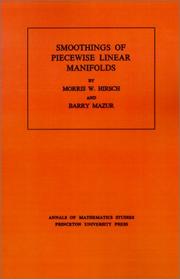
ISBN: 069108145X 1400881684 Year: 1974 Volume: no. 80 Publisher: Princeton : Princeton University Press,
Abstract | Keywords | Export | Availability | Bookmark
 Loading...
Loading...Choose an application
- Reference Manager
- EndNote
- RefWorks (Direct export to RefWorks)
The intention of the authors is to examine the relationship between piecewise linear structure and differential structure: a relationship, they assert, that can be understood as a homotopy obstruction theory, and, hence, can be studied by using the traditional techniques of algebraic topology.Thus the book attacks the problem of existence and classification (up to isotopy) of differential structures compatible with a given combinatorial structure on a manifold. The problem is completely "solved" in the sense that it is reduced to standard problems of algebraic topology.The first part of the book is purely geometrical; it proves that every smoothing of the product of a manifold M and an interval is derived from an essentially unique smoothing of M. In the second part this result is used to translate the classification of smoothings into the problem of putting a linear structure on the tangent microbundle of M. This in turn is converted to the homotopy problem of classifying maps from M into a certain space PL/O. The set of equivalence classes of smoothings on M is given a natural abelian group structure.
Algebraic topology --- Piecewise linear topology --- Manifolds (Mathematics) --- Topologie linéaire par morceaux --- Variétés (Mathématiques) --- 515.16 --- PL topology --- Topology --- Geometry, Differential --- Topology of manifolds --- Piecewise linear topology. --- Manifolds (Mathematics). --- 515.16 Topology of manifolds --- Topologie linéaire par morceaux --- Variétés (Mathématiques) --- Affine transformation. --- Approximation. --- Associative property. --- Bijection. --- Bundle map. --- Classification theorem. --- Codimension. --- Coefficient. --- Cohomology. --- Commutative property. --- Computation. --- Convex cone. --- Convolution. --- Corollary. --- Counterexample. --- Diffeomorphism. --- Differentiable function. --- Differentiable manifold. --- Differential structure. --- Dimension. --- Direct proof. --- Division by zero. --- Embedding. --- Empty set. --- Equivalence class. --- Equivalence relation. --- Euclidean space. --- Existential quantification. --- Exponential map (Lie theory). --- Fiber bundle. --- Fibration. --- Functor. --- Grassmannian. --- H-space. --- Homeomorphism. --- Homotopy. --- Integral curve. --- Inverse problem. --- Isomorphism class. --- K0. --- Linearization. --- Manifold. --- Mathematical induction. --- Milnor conjecture. --- Natural transformation. --- Neighbourhood (mathematics). --- Normal bundle. --- Obstruction theory. --- Open set. --- Partition of unity. --- Piecewise linear. --- Polyhedron. --- Reflexive relation. --- Regular map (graph theory). --- Sheaf (mathematics). --- Smoothing. --- Smoothness. --- Special case. --- Submanifold. --- Tangent bundle. --- Tangent vector. --- Theorem. --- Topological manifold. --- Topological space. --- Topology. --- Transition function. --- Transitive relation. --- Vector bundle. --- Vector field. --- Variétés topologiques
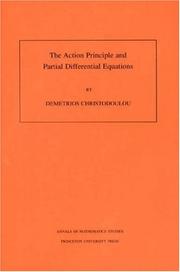
ISBN: 0691049572 0691049564 1400882680 Year: 2000 Volume: no. 146 Publisher: Princeton Princeton University press
Abstract | Keywords | Export | Availability | Bookmark
 Loading...
Loading...Choose an application
- Reference Manager
- EndNote
- RefWorks (Direct export to RefWorks)
This book introduces new methods in the theory of partial differential equations derivable from a Lagrangian. These methods constitute, in part, an extension to partial differential equations of the methods of symplectic geometry and Hamilton-Jacobi theory for Lagrangian systems of ordinary differential equations. A distinguishing characteristic of this approach is that one considers, at once, entire families of solutions of the Euler-Lagrange equations, rather than restricting attention to single solutions at a time. The second part of the book develops a general theory of integral identities, the theory of "compatible currents," which extends the work of E. Noether. Finally, the third part introduces a new general definition of hyperbolicity, based on a quadratic form associated with the Lagrangian, which overcomes the obstacles arising from singularities of the characteristic variety that were encountered in previous approaches. On the basis of the new definition, the domain-of-dependence theorem and stability properties of solutions are derived. Applications to continuum mechanics are discussed throughout the book. The last chapter is devoted to the electrodynamics of nonlinear continuous media.
Differentiaalvergelijkingen [Hyperbolische ] --- Differential equations [Hyperbolic] --- Equations différentielles hyperboliques --- Symplectic manifolds --- Differential equations, Hyperbolic. --- Symplectic manifolds. --- Variétés symplectiques --- Equations différentielles hyperboliques --- Variétés symplectiques --- Manifolds, Symplectic --- Geometry, Differential --- Manifolds (Mathematics) --- Hyperbolic differential equations --- Differential equations, Partial --- Action (physics). --- Boundary value problem. --- Canonical form. --- Causal structure. --- Classical mechanics. --- Complex analysis. --- Configuration space. --- Conservative vector field. --- Conserved current. --- Conserved quantity. --- Continuum mechanics. --- Derivative. --- Diffeomorphism. --- Differentiable manifold. --- Differential geometry. --- Dimension. --- Dimensional analysis. --- Dirichlet's principle. --- Einstein field equations. --- Electromagnetic field. --- Equation. --- Equations of motion. --- Equivalence class. --- Error term. --- Euclidean space. --- Euler system. --- Euler's equations (rigid body dynamics). --- Euler–Lagrange equation. --- Existence theorem. --- Existential quantification. --- Exponential map (Lie theory). --- Exponential map (Riemannian geometry). --- Exterior derivative. --- Fiber bundle. --- Foliation. --- Fritz John. --- General relativity. --- Hamiltonian mechanics. --- Hamilton–Jacobi equation. --- Harmonic map. --- Hessian matrix. --- Holomorphic function. --- Hyperbolic partial differential equation. --- Hyperplane. --- Hypersurface. --- Identity element. --- Iteration. --- Iterative method. --- Lagrangian (field theory). --- Lagrangian. --- Legendre transformation. --- Lie algebra. --- Linear approximation. --- Linear differential equation. --- Linear map. --- Linear span. --- Linearity. --- Linearization. --- Maximum principle. --- Maxwell's equations. --- Nonlinear system. --- Open set. --- Ordinary differential equation. --- Orthogonal complement. --- Parameter. --- Partial differential equation. --- Phase space. --- Pointwise. --- Poisson bracket. --- Polynomial. --- Principal part. --- Principle of least action. --- Probability. --- Pullback bundle. --- Pullback. --- Quadratic form. --- Quantity. --- Requirement. --- Riemannian manifold. --- Second derivative. --- Simultaneous equations. --- Special case. --- State function. --- Stokes' theorem. --- Subset. --- Surjective function. --- Symplectic geometry. --- Tangent bundle. --- Tangent vector. --- Theorem. --- Theoretical physics. --- Theory. --- Underdetermined system. --- Variable (mathematics). --- Vector bundle. --- Vector field. --- Vector space. --- Volume form. --- Zero of a function. --- Zero set.
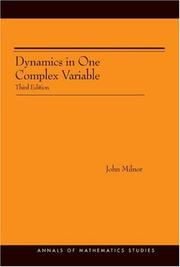
ISBN: 9780691124889 9780691124872 0691124884 0691124876 9786613001481 1400835534 1283001489 9781400835539 9781283001489 6613001481 Year: 2011 Publisher: Princeton, NJ
Abstract | Keywords | Export | Availability | Bookmark
 Loading...
Loading...Choose an application
- Reference Manager
- EndNote
- RefWorks (Direct export to RefWorks)
This volume studies the dynamics of iterated holomorphic mappings from a Riemann surface to itself, concentrating on the classical case of rational maps of the Riemann sphere. This subject is large and rapidly growing. These lectures are intended to introduce some key ideas in the field, and to form a basis for further study. The reader is assumed to be familiar with the rudiments of complex variable theory and of two-dimensional differential geometry, as well as some basic topics from topology. This third edition contains a number of minor additions and improvements: A historical survey has been added, the definition of Lattés map has been made more inclusive, and the écalle-Voronin theory of parabolic points is described. The résidu itératif is studied, and the material on two complex variables has been expanded. Recent results on effective computability have been added, and the references have been expanded and updated. Written in his usual brilliant style, the author makes difficult mathematics look easy. This book is a very accessible source for much of what has been accomplished in the field.
Functions of complex variables --- Holomorphic mappings --- Riemann surfaces --- Fonctions d'une variable complexe --- Applications holomorphes --- Riemann, surfaces de --- Holomorphic mappings. --- Mappings, Holomorphic --- Functions of complex variables. --- Riemann surfaces. --- Surfaces, Riemann --- Functions --- Functions of several complex variables --- Mappings (Mathematics) --- Complex variables --- Elliptic functions --- Functions of real variables --- Absolute value. --- Addition. --- Algebraic equation. --- Attractor. --- Automorphism. --- Beltrami equation. --- Blaschke product. --- Boundary (topology). --- Branched covering. --- Coefficient. --- Compact Riemann surface. --- Compact space. --- Complex analysis. --- Complex number. --- Complex plane. --- Computation. --- Connected component (graph theory). --- Connected space. --- Constant function. --- Continued fraction. --- Continuous function. --- Coordinate system. --- Corollary. --- Covering space. --- Cross-ratio. --- Derivative. --- Diagram (category theory). --- Diameter. --- Diffeomorphism. --- Differentiable manifold. --- Disjoint sets. --- Disjoint union. --- Disk (mathematics). --- Division by zero. --- Equation. --- Euler characteristic. --- Existential quantification. --- Exponential map (Lie theory). --- Fundamental group. --- Harmonic function. --- Holomorphic function. --- Homeomorphism. --- Hyperbolic geometry. --- Inequality (mathematics). --- Integer. --- Inverse function. --- Irrational rotation. --- Iteration. --- Jordan curve theorem. --- Julia set. --- Lebesgue measure. --- Lecture. --- Limit point. --- Line segment. --- Linear map. --- Linearization. --- Mandelbrot set. --- Mathematical analysis. --- Maximum modulus principle. --- Metric space. --- Monotonic function. --- Montel's theorem. --- Normal family. --- Open set. --- Orbifold. --- Parameter space. --- Parameter. --- Periodic point. --- Point at infinity. --- Polynomial. --- Power series. --- Proper map. --- Quadratic function. --- Rational approximation. --- Rational function. --- Rational number. --- Real number. --- Riemann sphere. --- Riemann surface. --- Root of unity. --- Rotation number. --- Schwarz lemma. --- Scientific notation. --- Sequence. --- Simply connected space. --- Special case. --- Subgroup. --- Subsequence. --- Subset. --- Summation. --- Tangent space. --- Theorem. --- Topological space. --- Topology. --- Uniform convergence. --- Uniformization theorem. --- Unit circle. --- Unit disk. --- Upper half-plane. --- Winding number.
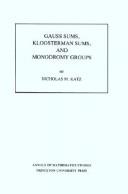
ISBN: 0691084335 0691084327 1400882125 Year: 1988 Volume: vol 116 Publisher: Princeton : Princeton University Press,
Abstract | Keywords | Export | Availability | Bookmark
 Loading...
Loading...Choose an application
- Reference Manager
- EndNote
- RefWorks (Direct export to RefWorks)
The study of exponential sums over finite fields, begun by Gauss nearly two centuries ago, has been completely transformed in recent years by advances in algebraic geometry, culminating in Deligne's work on the Weil Conjectures. It now appears as a very attractive mixture of algebraic geometry, representation theory, and the sheaf-theoretic incarnations of such standard constructions of classical analysis as convolution and Fourier transform. The book is simultaneously an account of some of these ideas, techniques, and results, and an account of their application to concrete equidistribution questions concerning Kloosterman sums and Gauss sums.
Group theory --- Algebraic geometry --- Number theory --- 511.33 --- Analytical and multiplicative number theory. Asymptotics. Sieves etc. --- 511.33 Analytical and multiplicative number theory. Asymptotics. Sieves etc. --- Gaussian sums --- Homology theory --- Kloosterman sums --- Monodromy groups --- Kloostermann sums --- Sums, Kloosterman --- Sums, Kloostermann --- Exponential sums --- Cohomology theory --- Contrahomology theory --- Algebraic topology --- Gauss sums --- Sums, Gaussian --- Analytical and multiplicative number theory. Asymptotics. Sieves etc --- Gaussian sums. --- Kloosterman sums. --- Homology theory. --- Monodromy groups. --- Number theory. --- Nombres, Théorie des. --- Exponential sums. --- Sommes exponentielles. --- Arithmetic --- Arithmétique --- Geometry, Algebraic. --- Géométrie algébrique --- Abelian category. --- Absolute Galois group. --- Absolute value. --- Additive group. --- Adjoint representation. --- Affine variety. --- Algebraic group. --- Automorphic form. --- Automorphism. --- Big O notation. --- Cartan subalgebra. --- Characteristic polynomial. --- Classification theorem. --- Coefficient. --- Cohomology. --- Cokernel. --- Combination. --- Commutator. --- Compactification (mathematics). --- Complex Lie group. --- Complex number. --- Conjugacy class. --- Continuous function. --- Convolution theorem. --- Convolution. --- Determinant. --- Diagonal matrix. --- Dimension (vector space). --- Direct sum. --- Dual basis. --- Eigenvalues and eigenvectors. --- Empty set. --- Endomorphism. --- Equidistribution theorem. --- Estimation. --- Exactness. --- Existential quantification. --- Exponential sum. --- Exterior algebra. --- Faithful representation. --- Finite field. --- Finite group. --- Four-dimensional space. --- Frobenius endomorphism. --- Fundamental group. --- Fundamental representation. --- Galois group. --- Gauss sum. --- Homomorphism. --- Integer. --- Irreducibility (mathematics). --- Isomorphism class. --- Kloosterman sum. --- L-function. --- Leray spectral sequence. --- Lie algebra. --- Lie theory. --- Maximal compact subgroup. --- Method of moments (statistics). --- Monodromy theorem. --- Monodromy. --- Morphism. --- Multiplicative group. --- Natural number. --- Nilpotent. --- Open problem. --- P-group. --- Pairing. --- Parameter space. --- Parameter. --- Partially ordered set. --- Perfect field. --- Point at infinity. --- Polynomial ring. --- Prime number. --- Quotient group. --- Representation ring. --- Representation theory. --- Residue field. --- Riemann hypothesis. --- Root of unity. --- Sheaf (mathematics). --- Simple Lie group. --- Skew-symmetric matrix. --- Smooth morphism. --- Special case. --- Spin representation. --- Subgroup. --- Support (mathematics). --- Symmetric matrix. --- Symplectic group. --- Symplectic vector space. --- Tensor product. --- Theorem. --- Trace (linear algebra). --- Trivial representation. --- Variable (mathematics). --- Weil conjectures. --- Weyl character formula. --- Zariski topology.
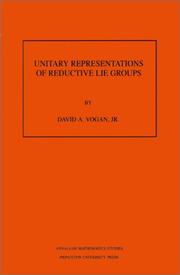
ISBN: 0691084815 0691084823 1400882389 9780691084824 9780691084817 Year: 1987 Publisher: Princeton : Princeton University Press,
Abstract | Keywords | Export | Availability | Bookmark
 Loading...
Loading...Choose an application
- Reference Manager
- EndNote
- RefWorks (Direct export to RefWorks)
This book is an expanded version of the Hermann Weyl Lectures given at the Institute for Advanced Study in January 1986. It outlines some of what is now known about irreducible unitary representations of real reductive groups, providing fairly complete definitions and references, and sketches (at least) of most proofs. The first half of the book is devoted to the three more or less understood constructions of such representations: parabolic induction, complementary series, and cohomological parabolic induction. This culminates in the description of all irreducible unitary representation of the general linear groups. For other groups, one expects to need a new construction, giving "unipotent representations." The latter half of the book explains the evidence for that expectation and suggests a partial definition of unipotent representations.
Lie groups --- Representations of Lie groups --- Lie groups. --- Representations of Lie groups. --- 512.81 --- Groups, Lie --- Lie algebras --- Symmetric spaces --- Topological groups --- 512.81 Lie groups --- Abelian group. --- Adjoint representation. --- Annihilator (ring theory). --- Atiyah–Singer index theorem. --- Automorphic form. --- Automorphism. --- Cartan subgroup. --- Circle group. --- Class function (algebra). --- Classification theorem. --- Cohomology. --- Commutator subgroup. --- Complete metric space. --- Complex manifold. --- Conjugacy class. --- Cotangent space. --- Dimension (vector space). --- Discrete series representation. --- Dixmier conjecture. --- Dolbeault cohomology. --- Duality (mathematics). --- Eigenvalues and eigenvectors. --- Exponential map (Lie theory). --- Exponential map (Riemannian geometry). --- Exterior algebra. --- Function space. --- Group homomorphism. --- Harmonic analysis. --- Hecke algebra. --- Hilbert space. --- Hodge theory. --- Holomorphic function. --- Holomorphic vector bundle. --- Homogeneous space. --- Homomorphism. --- Induced representation. --- Infinitesimal character. --- Inner automorphism. --- Invariant subspace. --- Irreducibility (mathematics). --- Irreducible representation. --- Isometry group. --- Isometry. --- K-finite. --- Kazhdan–Lusztig polynomial. --- Langlands decomposition. --- Lie algebra cohomology. --- Lie algebra representation. --- Lie algebra. --- Lie group action. --- Lie group. --- Mathematical induction. --- Maximal compact subgroup. --- Measure (mathematics). --- Minkowski space. --- Nilpotent group. --- Orbit method. --- Orthogonal group. --- Parabolic induction. --- Principal homogeneous space. --- Principal series representation. --- Projective space. --- Pseudo-Riemannian manifold. --- Pullback (category theory). --- Ramanujan–Petersson conjecture. --- Reductive group. --- Regularity theorem. --- Representation of a Lie group. --- Representation theorem. --- Representation theory. --- Riemann sphere. --- Riemannian manifold. --- Schwartz space. --- Semisimple Lie algebra. --- Sheaf (mathematics). --- Sign (mathematics). --- Special case. --- Spectral theory. --- Sub"ient. --- Subgroup. --- Support (mathematics). --- Symplectic geometry. --- Symplectic group. --- Symplectic vector space. --- Tangent space. --- Tautological bundle. --- Theorem. --- Topological group. --- Topological space. --- Trivial representation. --- Unitary group. --- Unitary matrix. --- Unitary representation. --- Universal enveloping algebra. --- Vector bundle. --- Weyl algebra. --- Weyl character formula. --- Weyl group. --- Zariski's main theorem. --- Zonal spherical function. --- Représentations de groupes de Lie --- Groupes de lie --- Representation des groupes de lie
Book
ISBN: 9781400863174 1400863171 0691632553 Year: 2014 Publisher: Princeton, NJ
Abstract | Keywords | Export | Availability | Bookmark
 Loading...
Loading...Choose an application
- Reference Manager
- EndNote
- RefWorks (Direct export to RefWorks)
The aim of this work is to provide a proof of the nonlinear gravitational stability of the Minkowski space-time. More precisely, the book offers a constructive proof of global, smooth solutions to the Einstein Vacuum Equations, which look, in the large, like the Minkowski space-time. In particular, these solutions are free of black holes and singularities. The work contains a detailed description of the sense in which these solutions are close to the Minkowski space-time, in all directions. It thus provides the mathematical framework in which we can give a rigorous derivation of the laws of gravitation proposed by Bondi. Moreover, it establishes other important conclusions concerning the nonlinear character of gravitational radiation. The authors obtain their solutions as dynamic developments of all initial data sets, which are close, in a precise manner, to the flat initial data set corresponding to the Minkowski space-time. They thus establish the global dynamic stability of the latter.Originally published in 1994.The Princeton Legacy Library uses the latest print-on-demand technology to again make available previously out-of-print books from the distinguished backlist of Princeton University Press. These editions preserve the original texts of these important books while presenting them in durable paperback and hardcover editions. The goal of the Princeton Legacy Library is to vastly increase access to the rich scholarly heritage found in the thousands of books published by Princeton University Press since its founding in 1905.
Space and time --- Generalized spaces --- Nonlinear theories --- Physics --- Physical Sciences & Mathematics --- Atomic Physics --- Nonlinear problems --- Nonlinearity (Mathematics) --- Calculus --- Mathematical analysis --- Mathematical physics --- Geometry of paths --- Minkowski space --- Spaces, Generalized --- Weyl space --- Calculus of tensors --- Geometry, Differential --- Geometry, Non-Euclidean --- Hyperspace --- Relativity (Physics) --- Space of more than three dimensions --- Space-time --- Space-time continuum --- Space-times --- Spacetime --- Time and space --- Fourth dimension --- Infinite --- Metaphysics --- Philosophy --- Space sciences --- Time --- Beginning --- Mathematics --- Angular momentum operator. --- Asymptotic analysis. --- Asymptotic expansion. --- Big O notation. --- Boundary value problem. --- Cauchy–Riemann equations. --- Coarea formula. --- Coefficient. --- Compactification (mathematics). --- Comparison theorem. --- Corollary. --- Covariant derivative. --- Curvature tensor. --- Curvature. --- Cut locus (Riemannian manifold). --- Degeneracy (mathematics). --- Degrees of freedom (statistics). --- Derivative. --- Diffeomorphism. --- Differentiable function. --- Eigenvalues and eigenvectors. --- Eikonal equation. --- Einstein field equations. --- Equation. --- Error term. --- Estimation. --- Euclidean space. --- Existence theorem. --- Existential quantification. --- Exponential map (Lie theory). --- Exponential map (Riemannian geometry). --- Exterior (topology). --- Foliation. --- Fréchet derivative. --- Geodesic curvature. --- Geodesic. --- Geodesics in general relativity. --- Geometry. --- Hodge dual. --- Homotopy. --- Hyperbolic partial differential equation. --- Hypersurface. --- Hölder's inequality. --- Identity (mathematics). --- Infinitesimal generator (stochastic processes). --- Integral curve. --- Intersection (set theory). --- Isoperimetric inequality. --- Laplace's equation. --- Lie algebra. --- Lie derivative. --- Linear equation. --- Linear map. --- Logarithm. --- Lorentz group. --- Lp space. --- Mass formula. --- Mean curvature. --- Metric tensor. --- Minkowski space. --- Nonlinear system. --- Normal (geometry). --- Null hypersurface. --- Orthonormal basis. --- Partial derivative. --- Poisson's equation. --- Projection (linear algebra). --- Quantity. --- Radial function. --- Ricci curvature. --- Riemann curvature tensor. --- Riemann surface. --- Riemannian geometry. --- Riemannian manifold. --- Sard's theorem. --- Scalar (physics). --- Scalar curvature. --- Scale invariance. --- Schwarzschild metric. --- Second derivative. --- Second fundamental form. --- Sobolev inequality. --- Sobolev space. --- Stokes formula. --- Stokes' theorem. --- Stress–energy tensor. --- Symmetric tensor. --- Symmetrization. --- Tangent space. --- Tensor product. --- Theorem. --- Trace (linear algebra). --- Transversal (geometry). --- Triangle inequality. --- Uniformization theorem. --- Unit sphere. --- Vector field. --- Volume element. --- Wave equation. --- Weyl tensor.
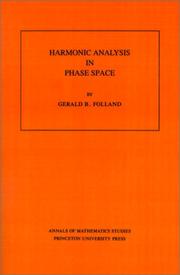
ISBN: 0691085277 0691085285 1400882427 9780691085289 9780691085272 Year: 2016 Volume: 122 Publisher: Princeton, NJ : Princeton University Press,
Abstract | Keywords | Export | Availability | Bookmark
 Loading...
Loading...Choose an application
- Reference Manager
- EndNote
- RefWorks (Direct export to RefWorks)
This book provides the first coherent account of the area of analysis that involves the Heisenberg group, quantization, the Weyl calculus, the metaplectic representation, wave packets, and related concepts. This circle of ideas comes principally from mathematical physics, partial differential equations, and Fourier analysis, and it illuminates all these subjects. The principal features of the book are as follows: a thorough treatment of the representations of the Heisenberg group, their associated integral transforms, and the metaplectic representation; an exposition of the Weyl calculus of pseudodifferential operators, with emphasis on ideas coming from harmonic analysis and physics; a discussion of wave packet transforms and their applications; and a new development of Howe's theory of the oscillator semigroup.
Harmonic analysis. Fourier analysis --- Phase space (Statistical physics) --- Harmonic analysis --- 512.54 <043> --- 530.145 <043> --- 517.986.6 --- 51-7 <043> --- 517.986.6 <043> --- Groups. Group theory--Dissertaties --- Quantum theory--Dissertaties --- Harmonic analysis of functions of groups and homogeneous spaces --- Mathematical studies and methods in other sciences. Scientific mathematics. Actuarial mathematics. Biometrics. Econometrics etc.--Dissertaties --- Harmonic analysis of functions of groups and homogeneous spaces--Dissertaties --- 517.986.6 <043> Harmonic analysis of functions of groups and homogeneous spaces--Dissertaties --- 51-7 <043> Mathematical studies and methods in other sciences. Scientific mathematics. Actuarial mathematics. Biometrics. Econometrics etc.--Dissertaties --- 517.986.6 Harmonic analysis of functions of groups and homogeneous spaces --- 530.145 <043> Quantum theory--Dissertaties --- 512.54 <043> Groups. Group theory--Dissertaties --- Space, Phase (Statistical physics) --- Generalized spaces --- Analysis (Mathematics) --- Functions, Potential --- Potential functions --- Banach algebras --- Calculus --- Mathematical analysis --- Mathematics --- Bessel functions --- Fourier series --- Harmonic functions --- Time-series analysis --- Harmonic analysis. --- Analytic continuation. --- Analytic function. --- Antisymmetric tensor. --- Asymptotic expansion. --- Automorphism. --- Bilinear form. --- Bounded operator. --- Calculation. --- Canonical commutation relation. --- Canonical transformation. --- Cauchy–Riemann equations. --- Cayley transform. --- Class function (algebra). --- Classical mechanics. --- Commutative property. --- Complex analysis. --- Configuration space. --- Differential equation. --- Differential geometry. --- Differential operator. --- Eigenvalues and eigenvectors. --- Equation. --- Explicit formula. --- Fock space. --- Fourier analysis. --- Fourier integral operator. --- Fourier transform. --- Functional analysis. --- Gaussian function. --- Gaussian integral. --- Geometric quantization. --- Hamiltonian mechanics. --- Hamiltonian vector field. --- Heisenberg group. --- Hermite polynomials. --- Hermitian symmetric space. --- Hilbert space. --- Hilbert transform. --- Integral transform. --- Invariant subspace. --- Irreducible representation. --- Lebesgue measure. --- Lie algebra. --- Lie superalgebra. --- Lie theory. --- Mathematical physics. --- Number theory. --- Observable. --- Ordinary differential equation. --- Orthonormal basis. --- Oscillator representation. --- Oscillatory integral. --- Partial differential equation. --- Phase factor. --- Phase space. --- Point at infinity. --- Poisson bracket. --- Polynomial. --- Power series. --- Probability. --- Projection (linear algebra). --- Projective Hilbert space. --- Projective representation. --- Projective space. --- Pseudo-differential operator. --- Pullback (category theory). --- Quadratic function. --- Quantum harmonic oscillator. --- Quantum mechanics. --- Representation theory. --- Schrödinger equation. --- Self-adjoint operator. --- Semigroup. --- Several complex variables. --- Siegel disc. --- Sobolev space. --- Spectral theorem. --- Spectral theory. --- State-space representation. --- Stone's theorem. --- Stone–Weierstrass theorem. --- Summation. --- Symmetric space. --- Symmetric tensor. --- Symplectic geometry. --- Symplectic group. --- Symplectic vector space. --- Symplectomorphism. --- Tangent space. --- Tangent vector. --- Theorem. --- Translational symmetry. --- Unbounded operator. --- Unit vector. --- Unitarity (physics). --- Unitary operator. --- Unitary representation. --- Variable (mathematics). --- Wave packet.
| Listing 1 - 8 of 8 |
Sort by
|

 Search
Search Feedback
Feedback About UniCat
About UniCat  Help
Help News
News